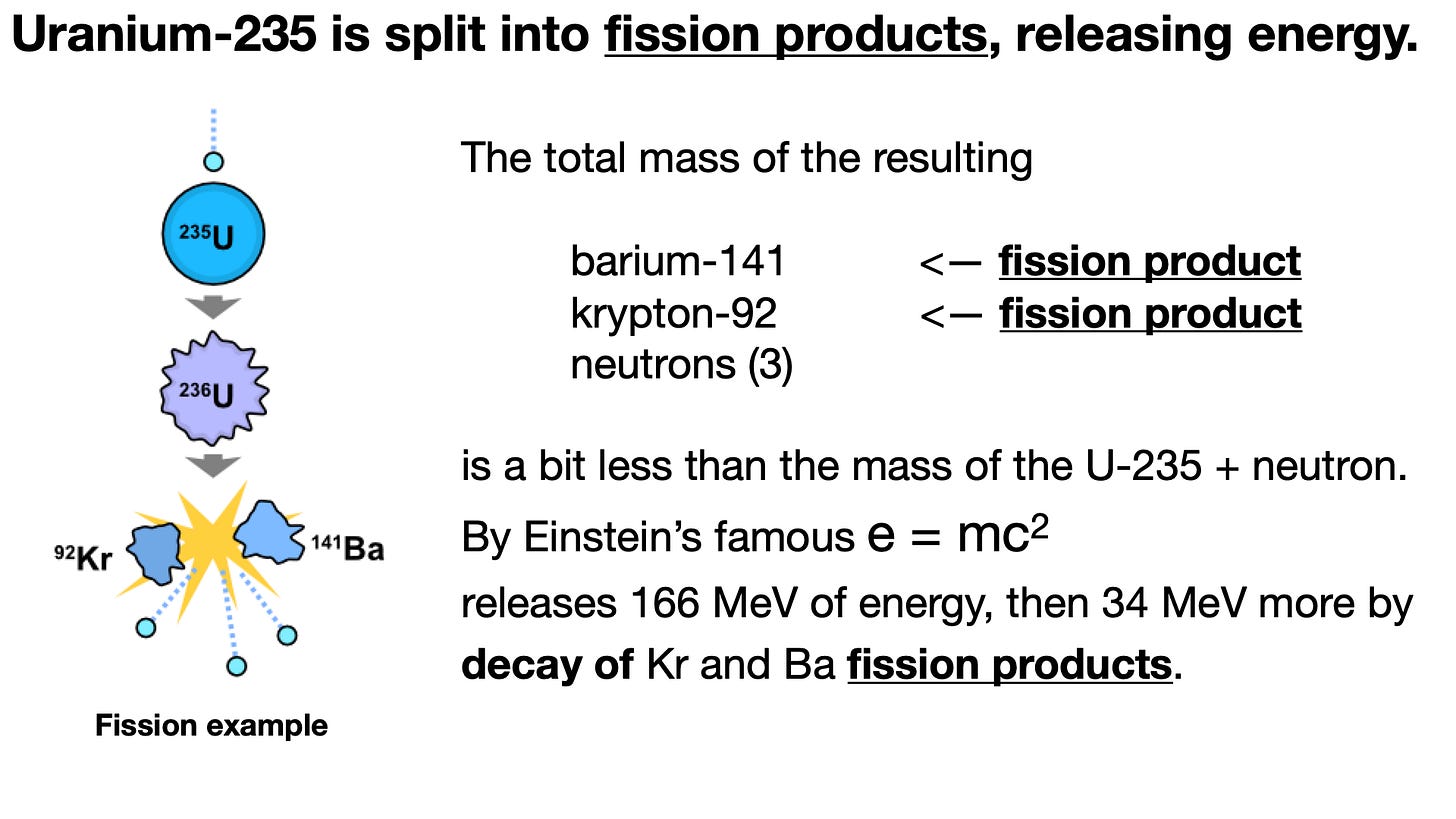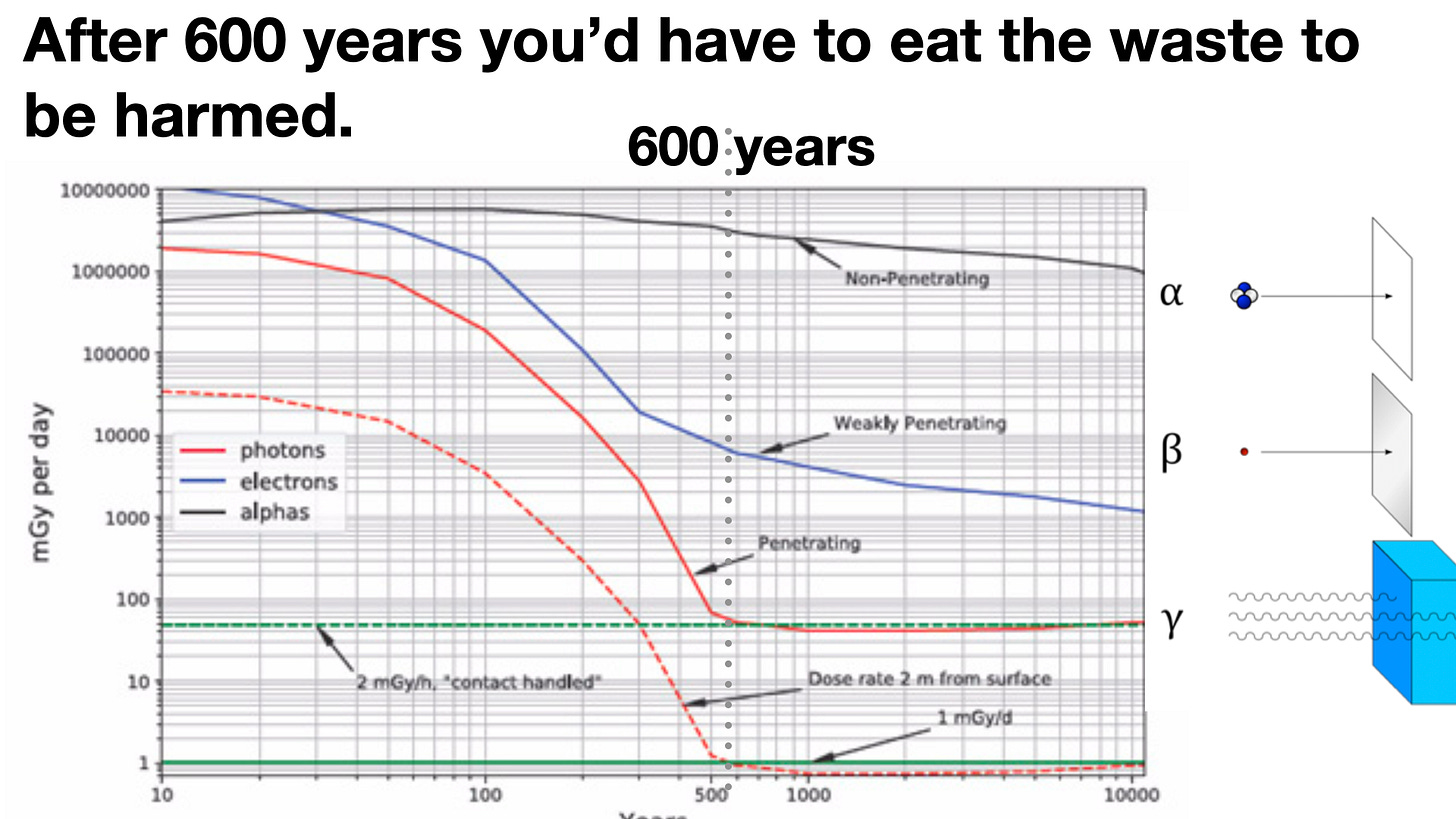This post continues on from
Nuclear power radiation is generally benign.
Regulators have little understanding of the biology, and they ignore the observations.
A prosperous world includes promoting people in developing nations from poverty to modest prosperity, with food, water, housing, sanitation, transportation, education, jobs and satisfaction with small families. Reliable, ample, affordable energy from low cost nuclear power plants enables such progress.
A temperate world can be maintained by checking unfettered emissions of CO2 into the atmosphere from burning fossil fuels for energy. The ‘green energy transition’ has failed. Nuclear power plants emit no CO2 but are now too expensive. Nuclear must be cheaper than coal for generating electricity, or else the developing countries will continue to build coal-fired power plants.
Nuclear will not be cheaper than coal until fact-blind regulators are dethroned.
But what about the waste?
The radiation from aged, recovered fuel is benign, as long as we don’t eat it. Here is the explanation, starting with the original, energy releasing fission.
The fission product atoms speed away from the fission event. Collisions with other atoms create thermal energy, used to heat water to steam to spin a turbine-generator. The fission products are typically radioactive, decaying to other atoms or releasing small subatomic particles. Even after fission stops, fission products are potentially active until they and their progeny decay to stable atoms, seconds to millennia later. In the example above, 34/200 (17%) of the energy is released after fission stops.
Water is very useful in nuclear reactors. Water slows neutrons to speeds that let them fission uranium.
Water cools the fuel rods and flows to transfer thermal energy to a steam generator, a device vaguely like an underwater car radiator.
Water shields the nuclear plant workers from neutrons and radioactive alpha, beta, and gamma particles.
In recovered, used fuel the heavy metals such as uranium, neptunium, and plutonium decay slowly, emitting alpha particles. The heavy metals are not very radioactive because they have long half lives.
Fission products generally emit beta or gamma particles when they decay. Their half lives are much shorter than those of heavy metals. Fission products decay in fractions of seconds to thousands of years. Highly radioactive ones disappear quickly so are not concerning for long. Long lived ones aren’t very harmful because decays are so infrequent. Ones with half lives of decades can be troubling because their radioactivity persists in timescales of decades and are moderately radioactive. Strontium-90 and Cesium-137 are examples with half lives near 30 years.
Radioactive spent fuel rods from the nuclear reactor are cooled under water for a few years, then transferred to metal containers within concrete casks. The casks are passively cooled by air.
Fission products emit alpha, beta, and gamma particles. The alphas and betas are trivially absorbed. The gammas are penetrating, high energy photons, but the casks absorb them. so it’s safe to hug the casks for unlimited periods.
By 100 years or less, we may want to repackage and compact the spent fuel in new, fewer casks. By then recovered fuel radioactivity is much lower so repackaging will be easy and safe.
Jack Devanney computed this display of radioactivity of spent fuel, by decay particle type. The black top line (Non-Penetrating) shows alpha particle radiation in units of mGy. Multiply mGy (energy) by 20 to get mSv (energy damage) because alphas are double-charged and slow for their energy.
Alphas come from heavy metal decays. Alphas don’t penetrate epidermis, but on intestine linings or lung air sacs alphas will contact live cells and can damage them.
The beta particles (Weekly Penetrating blue line) come largely from fission product decays.
The (Penetrating solid red) gamma particles are mostly from fission products. For these 1 mGy = 1 mSv.
The red dashed line presents the total dose to a person from all sources, measured 2 meters from the fuel rod.
Recovered, used fuel can be safely stored under water for a few years, in casks for a few centuries, then disposed of just like other toxic metals such as lead, arsenic, cadmium, mercury, or chromium. The recovered fuel will be harmless unless you eat it. There is no need to spend billions of dollars for underground caverns.
By the 22nd century we may well re-use this recovered fuel, which still contains over 90% of uranium’s potential energy, using emerging “fast” reactor technology.
For the same energy production, recovered fuel in casks occupies a lot less land area than waste from other energy sources.
If we set radiation limits to the historical 2 mSv/day tolerance rate, people will exposed to at most a tenth of observed, safely tolerated radiation dose rate of 20 mSv/day.
The used, recovered fuel can be safely stored in ground level casks.
The land area for nuclear power is small compared to that needed by dams, solar panels, or wind turbines.
Regulators have ratcheted down radiation exposure limits and created needless rules that made nuclear power exorbitantly expensive.
Low cost nuclear can raise living standards in developing nations, which will otherwise build more coal-fired power plants. Low cost energy also improves economies of wealthy nations.
CO2 emissions can be checked by using nuclear power for all electric power generation, for heating buildings in cities, for small vehicle transportation, and for future e-fuels and even some industrial processes such as iron production.
Many scientists, too, deserve blame for misinforming regulators of effects of nuclear power radiation. Like media headline writers, scientists also seek attention with fear-arousing journal articles in order to get research grants or advance professionally in highly competitive academia. Many are in control of NGOs such as International Council on Radiation Protection, where they elaborate the myth of LNT and simply ignore conflicting observational evidence.
President Kennedy was a strong supporter of nuclear power.
Regulators and leaders of many NGOs are lazy, comfortable in the status quo, and unwilling even to read, study, or consider alternatives to the current regime of radiation protection. “Written in stone” stated one US regulator of the LNT rule..
The US Nuclear Regulatory Commission is intransigent. It should be abolished.
Thorcon International is a company I helped found after retirement. The company objective is to have shipyards mass produce nuclear power plants that generate electric power at lower cost than new, coal fired plants. Developing nations will choose the least expensive source of reliable, ample electric power. The Thorcon 500 design choices minimize electric power costs. If they are lower than coal-fired plants electric power costs, Thorcon succeeds, nations prosper, and world CO2 emissions are lower.
Indonesia is endorsing nuclear power and encouraging the Thorcon company to build the prototype nuclear power plant on Kelasa Island north of the J in Jakarta.
The Thorcon 2050 goal is to be building 40 GW (80 units) of power plants per year. If each replaces a coal-fired plant, our effort will reduce global CO2 emissions by 9%. Indonesia officials have promised efficient regulation. Success will help raise prosperity in the developing world, making these nations more competitive internationally, and making the US reconsider the role and impact of NRC and EPA regulations.
















"Benign" is the best word, much less need for debate compared to "harmless" or "perfectly safe". This is the best writing on the topic I have ever seen. I have been thinking our audience is college educated. We really need to focus on the average level, 8th grade.
The graph shows alpha particles as lasting thousands of years with the dose being orders of magnitude higher than the other components of radiation. This needs explanation. Maybe that the dose per kg is so large, because the distance is so short. Alternatively, show total absorption in a human body. Then it needs less explanation. Also, if we could make the curves smoother, maybe from an actual simulation, it wouldn't look like just a rough guess.